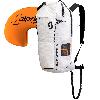Climbing skins for ski mountaineering - Maintenance and advice

 1 / 4
1 / 4 Planetmountain
Planetmountain
As all ski mountaineers well know, climbing skins are stuck to the bottom of the ski during an ascent, for they enable a smooth forward glide but impe any backwards slipping .
Most ski mountaineers have a love/hate relationship with this indispensible piece of equipment: who hasn't ever had problems with the cold glue, finding it almost impossible to stick the skins back on after a short descent?
And who hasn't struggled against those annoying lumps of snow that accumulate on the skin, requiring an awkward and ultimately tiring high step? And on the summit finally, who hasn't grappled with the skins as the flatter in the wind, sticking to everything instead of being packed away neatly?
All of these examples, apart from being highly frustrating, can easily jeapordise the outcome and fun of a tour. Lab has therefore analysed this piece of equipment carefully and listed plenty of helpful tips and tricks to prevent and solve any likely problems.
Types of climbing skins
Many different types of skins are available, but the three main determining factors are type of material, length of the skin and method of attatchment.
Synthetic materials or mohair are usually used and these often vary in hair length. Synthetic materials are considerably cheaper but perform worse, especially in icy conditions where they glide badly.
The "condition" of the skin is worth examining too; a "worn" skin will clearly be quick on undulating terrain, but on steeper or icy ground a newer, fatter skin which offers more friction will work much better. This approach is evident in competitions, where contestants carefully choose the skins according to the terrain and the prevailing snow conditions!
The climbing skin should be roughly 15cm shorter than the ski, leaving the tail free (during the ascent the tail plays only a marginal role and a full length skin produces extra drag). This is taken to extremes in competitions where the contestants use skins which go no further than the binding. By exploiting only the central part of the skin they save on weight, and their extremely rapid pace stops them from sliding back.
The width of the skin is important, too. This should be just slightly narrower than the ski itself, covering the waxy surface but not the edges. In particular the edges at the center of the ski, where the binding is situated, must be kept free otherwise the edge won't grip on steeper slopes. Nowadays most skis, in particular carving skis
Some ski mountaineers, instead of shortening the climbing skin as described, prefer to keep it as long as the ski and hook it to the tail (top-fix). An elastic strap keeps the skin tensioned and prevents the skin from becoming unstuck. This system is slightly heavier and produces more drag than the one mentioned earlier (it's easy to identify the tracks of someone who uses this system as the hook leaves an extra mark in the snow).
Each climbing skin comes with a device for attaching it to the tip of the ski. Many different methods have been invented, most of which are impractical, heavy and not robust. The most effective and widely used system still remains the traditional iron bracket (see photo). Racers in ski mountaineering competitions use home-made systems which can be taken off immediately, and eventually the technology used there will be produced commercially.
Maintenance
Climbing skins are relatively easy to maintain. The only three things which must be checked regularly are the stickiness of the skin and the state of the material and tail.
Examine carefully how sticky the glue is, especially around the tail as this becomes unstuck frequently. New glue can be easily applied on top of the old glue or, if you have plenty of time, the old layer can be removed before being replaced by a new layer. Sprays are great for emergency repairs on multi-day tours.
When not in use, fold the climbing skin on itself, along its sticky side. We recommend you forget about the plastic strips which accompany the skins - they are highly impractical in windy conditions and often the glue remains stuck on the plastic.
Specialised products can be used to treat the material of the climbing skin and ski wax is still highly effective at reducing friction and waterproofing the skin.
The tail of the climbing skin should be rounded off to eliminate edges which cause the skin to become unstuck. Many competitiors shave a the mohair at the tip and tail so as to reduce drag and virtually eliminate the possibility of the skin becoming unstuck (see photo).
Some helpul advice if...
the climbing skin becomes unstuck
- keep it warm; under your clothes or, in extreme cases, with a lighter
- check that the ski is dry and rub it to warm the surface
- use double-sided sticky tape if the glue doesn't stick anymore
snow accumulates beneath the skin
- the only solution is to wax and waterproof the ski as soon as possible
during the tour something breaks
- a small repair kit should always be in the bottom of your rucksack, especially if the tour is longer than just one day. Emergency situations can be dealt with effectively until you get back home. The photo shows the items which make up a basic repair kit
Repair Kit
1 multi-purpose knife with pliers, screwdriver etc; extremely useful for mending the bindings
2 wire; to fix a binding, ski boot or climbing skin
3 sticky tape; the tape illustrated is nautical and
4 wax; lightweight and easy to carry, these can save the day
5 ski wax; cheap and easy to use, this can stop the snow from sticking to the climbing skin



 Copia link
Copia link
























